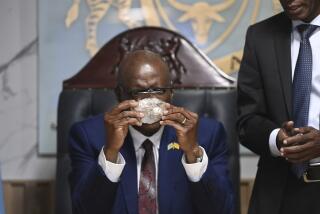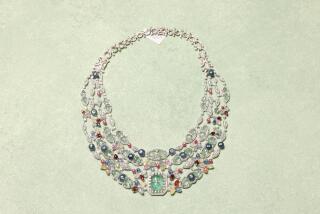For Coveted Hope Diamond, a New Setting
- Share via
WASHINGTON — Surrounded by proud curators and nervous guards, the Hope diamond traveled 75 paces to its new home Sunday.
“Isn’t it great? Isn’t it great?” enthused curator Jeffrey Post, who is in charge of the Smithsonian Institution’s gem collection. “I think it’s the first time it’s been displayed to look as good as it can look.”
The diamond was removed from its wall safe Sunday, placed in a black security case, taken to a back room for cleaning, then put in the new display. It will be the centerpiece of a new exhibit of gems and minerals, opening Saturday.
The blue-white Hope diamond, about the size of a walnut, is surrounded by 16 white diamonds and suspended from a platinum chain bearing 46 more diamonds.
In its new glass cylinder, it rotates beneath lights designed to show off the 45.52-carat stone. The room is called the Harry Winston Gallery for the New York jeweler who donated it to the Smithsonian.
The diamond originated in India, where it was acquired by French gem merchant Jean Baptiste Tavernier. He sold the stone, then weighing 112 carats, to France’s King Louis XIV, who had it recut to 67 carats.
Cut again to its current size, the diamond was sold to King George IV. After the king died, it was bought by London banker Henry Philip Hope. The diamond was bought by Evalyn Walsh McLean of Virginia in 1912 from Paris jeweler Pierre Cartier. Winston bought the gem from her estate and, in 1958, presented it to the Smithsonian, mailing it to the museum. It is considered priceless.
More to Read
Sign up for The Wild
We’ll help you find the best places to hike, bike and run, as well as the perfect silent spots for meditation and yoga.
You may occasionally receive promotional content from the Los Angeles Times.






